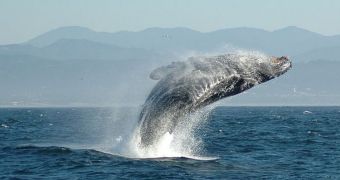As global warming gradually decreases the amount of ice covering seas around the North Pole, whale pods are beginning to meet up with other groups, from which they have been separated for thousands of years. Experts discovered the phenomenon in the Northwest Passage, north of Canada.
Biologists say that they were able to find bowhead pods mingling together in these freezing waters, but added that the larger groups were made up of members from both sides of the Canadian High Arctic regions, which is very uncommon.
Usually, the routes now traveled by the whales are sealed off by floating ices throughout the years. In recent years, however, warmer temperatures at the poles have constantly eroded these obstacles, to the point that they are now completely gone.
This new study was led by a team of scientists at the Greenland Institute of Natural Resources (GINR), which was coordinated by researcher Mads Peter Heide-Jørgensen. This group is the first to establish for certain that bowhead whale populations indeed mingle in the Northwestern Passage.
In order to gain some perspective, it is important to note here that the US National Snow and Ice Data Center (NSDIC) announced a few days ago that Arctic sea ice extents had a reach a minimum low for 2011, the second-lowest in recorded satellite history.
This may have had something to do with new meetings the whales have been having. Details of the new study were published in the September 21 online issue of the esteemed journal Biology Letters.
“Given recent rates of sea ice loss, climate change may eliminate geographical divisions between stocks of bowhead whales and open new areas that have not been inhabited by bowhead whales for millennia,” the GINR team explains in the paper.
Until 2009, satellite tags attached to these whales had indicated that the animals indeed attempted to foray into the Northwestern Passage, but that the thick ices had eventually blocked their paths. In 2010, data indicated that the obstacles were gone, LiveScience reports.
In August 2010, radio tags revealed that two male bowhead whales had made their way into the Passage, one from Greenland, and another one from Alaska. By that time, sea ice extents had reached their minimum for the year.

 14 DAY TRIAL //
14 DAY TRIAL //